
Hazel, Corylus: planting, pruning and care
Contents
Corylus in a nutshell
- The hazel comes in several types, each with its own characteristics. Hazels grown for their fruits offer an abundance of delicious hazelnuts. Additionally, ornamental bush hazels are distinguished by their purple foliage or the unique appearance of their twisted branches. As for the Byzantine hazel, it appears as a tree, adding an imposing structure to the landscape.
- These trees and bushes display remarkable hardiness, capable of thriving in various climatic conditions. They produce hazelnuts with varying yields, offering a range of shapes, colours, and flavours for the delight of gourmets and gardeners.
- The flowering of the hazel occurs early in the year. The long pendulous aments, emerging on naked branches, attract attention and pollinators with their highly decorative appearance and ability to produce nectar.
- The foliage of hazels, rounded, dentate, and well-veined, varies from dark green to purple. In autumn, it transforms into a magnificent golden yellow before falling, providing a striking visual display in any garden.
- Easy to grow and requiring little maintenance, hazels are rarely diseased. They withstand wind and pollution well, making them ideal candidates for free hedges, rural landscaping, or even urban alignments, particularly with Corylus colurna.
A word from our expert
The catkins adorning its naked branches towards the end of winter remind us how endearing the hazel tree is. It is one of the first trees to begin its reproductive cycle, provided it has a nearby partner to successfully carry out its plan! You will have to patiently wait until the end of summer to enjoy its hard-shelled fruits, which are highly energetic and rich in trace elements, and have the advantage of storing well in a dry state. Hazels have not remained merely as fruit trees.
Hazels, or Corylus in Latin, are bushes that form large clumps, commonly found within free or country hedges. These bushes, very easy to grow, offer a rounded, dentate foliage that turns a lovely yellow in autumn before falling. The twisted branches like corkscrews of Corylus avellana ‘Contorta’ add a magical effect to the scene. Its bare branches are used in floristry to give character to a floral arrangement or in the art of ikebana. The purple of Corylus maxima ‘Purpurea’ enhances the beauty of the foliage with its serrated edges forming a heart shape. The Purple twisted hazel (‘Red Majestic’) combines both characters with its sinuous branches adorned with purple foliage in spring, green in summer, and then red in autumn.
Hazels are very hardy (-30°C), although some varieties are sensitive to spring frosts. They can be found in Europe, Asia Minor, and northern Africa. From late December to early March, the flowering occurs in long purple or yellow catkins, attracting bees eager for pollen. Hazels can produce 7 to 12 kg when mature and begin to yield from the sixth year of cultivation. Corylus are planted in light, calcareous soil, even poor or stony, or cool but well-drained soil, in sunny or semi-shaded positions.
Description and Botany
Botanical data
- Latin name Corylus sp.
- Family Betulaceae
- Common name Hazel, Filbert
- Flowering between December and April
- Height between 3 and 15 m
- Exposure sun or partial shade
- Soil type any fresh to dry soil, even calcareous
- Hardiness Excellent (-34°C)
Hazels comprise 16 species of trees or bushes found in temperate regions of the northern hemisphere. The genus Corylus is one of the few flowering plants that appeared on Earth during the secondary era, over 70 million years ago, and has survived to this day.
It belongs to the Betulaceae family, like birch or hornbeam, characterised by distinct male and female aments but on the same tree.
The common hazel, Corylus avellana, is native to Europe, and numerous fossils of leaves and hazelnuts found in Neolithic burials attest to its use. It can be found at the edges of woods, in copses, and hedges almost everywhere in France.
Bushy hazels form several very straight stems 2 to 6 m high, creating a clump of about ten poles, initially erect, then spreading with age. The brown bark can peel off in thin strips. The lifespan of the common hazel is about 60 years, over 100 years for the Byzantine hazel. The heart-shaped leaves are dentate with a pointed tip and have marked parallel veins. The foliage is deciduous dark green, sometimes purple. The Byzantine hazel (Corylus colurna) is a tree species used as a street tree, recognisable by its almost lobed leaves; its cultivar ‘Te-Terra Red’ has purple foliage.
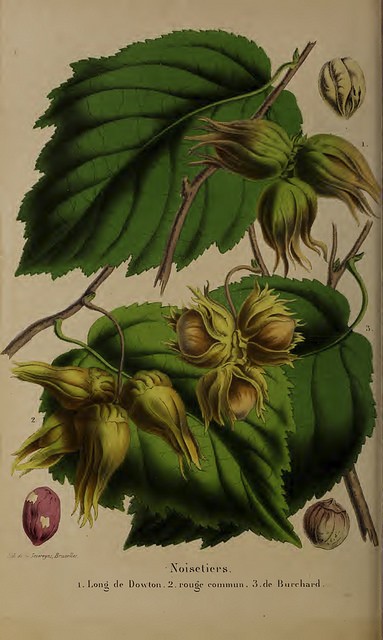
Corylus avellana – botanical illustration
The plant produces distinct male and female flowers on the same subject, which often do not mature at the same time, requiring the presence of other subjects with synchronous flowering for fertilisation. The male aments that adorn the bare branches are golden chains 4 to 10 cm long, blooming in February-March. The pollen dispersed by the wind attracts bees that are replenishing their reserves after the winter break. The female flowers are barely visible, buried in the buds, reduced to their simplest reproductive structure, the pistil, topped with red stigmas. They mature in March-April. To achieve a good production of hazelnuts, it is important to plant several varieties with compatible flowering. Sometimes the presence of hazels in the vicinity is enough to ensure the fertilisation of your tree, knowing that there are also self-fertile forms.
The fruit is an achene 1 to 2 cm long (a dry indehiscent fruit with a single seed), encased in a fringed husk, bright green turning brown at maturity, which gave the scientific name to this tree. Corylus indeed comes from the Greek Korys, meaning “hood”. In C. maxima, this involucre of bracts is longer and downy; in C. colurna, it is frizzy, and in purple varieties (Corylus maxima ‘Purpurea’, C. avellana ‘Rote Zellernuss’), its colour is pink-purple. Hazelnuts are generally grouped in small clusters of two or three fruits. Just before the fruit matures, the shell appears. It will harden and change colour while the almond concentrates on sugars, oils, and minerals. This ripening occurs in autumn, and harvesting takes place in late summer when the hazelnuts easily detach from the branches. Allow to dry for a few days to separate the hazelnut from its involucre. The first hazelnuts are expected to be harvested around the age of 5-6 years, reaching full production by 8-10 years until about 60 years of age. The storage of hazelnuts in a cool place exceeds one year.
The taste qualities of this dry fruit have made it a top ingredient in confectionery and pastry: grated into powder, crushed, or cut into shavings. An oil rich in omega 3, omega 9, vitamin E, vitamin B, and magnesium is also extracted, although it is prone to rancidity. It is also appreciated in massage and cosmetics for its nourishing, regenerating, healing, and antioxidant properties.

Inflorescences of hazels: male flowers of Corylus avellana, male flowers of Corylus avellana ‘Red Majestic’, and female flower of hazel.
The common hazel produces very straight branches, very useful for making stakes or canes. Formerly called Filbert, this bush was considered a plant associated with white magic. The Celts and the Germanic-Scandinavian peoples saw it as a symbol of knowledge and fertility, while Christians viewed it as a symbol of the devil.

Foliage of Corylus avellana, Corylus avellana ‘Red Majestic’, and twisted branches of Corylus avellana ‘Contorta’.
The main varieties of Corylus
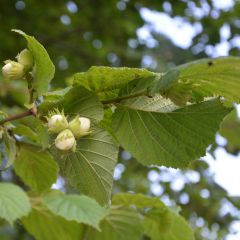
Hazel Merveille de Bollwiller - Corylus maxima
- Flowering time March
- Height at maturity 5 m
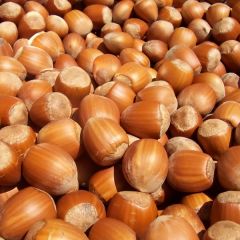
Commin Hazel Pearson's Prolific - Corylus avellana
- Flowering time March
- Height at maturity 5 m

Hazel Merveille de Bollwiller - Corylus maxima
- Flowering time March
- Height at maturity 5 m

Common Hazel Fertile de Coutard - Corylus avellana
- Flowering time March, April
- Height at maturity 5 m
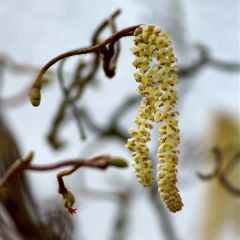
Corylus avellana Contorta - Common Hazel
- Flowering time March, April
- Height at maturity 3 m
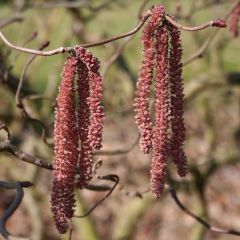
Corylus avellana Red Majestic - Common Hazel
- Flowering time March, April
- Height at maturity 2 m
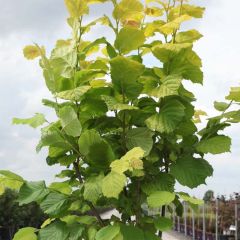
Corylus avellana Aurea - Common Hazel
- Flowering time March to May
- Height at maturity 3,50 m
Discover other Corylus - Hazelnuts
View all →Available in 1 sizes
Available in 4 sizes
Available in 1 sizes
Available in 3 sizes
Available in 1 sizes
Available in 3 sizes
Available in 1 sizes
Available in 2 sizes
Available in 1 sizes
Available in 1 sizes
Where, when, and how to plant a hazel tree?
Where to plant the Corylus?
Growing hazel is very easy in the garden, whether it is planted in a grove, as a free hedge, or in isolation. Very hardy, it thrives both in plains and in mountains, up to 1,500 m in altitude. This bush, 4-5 m high, sometimes becoming a tree, adapts to partial shade but flowers better in full sun.
It accepts all types of soil, even very calcareous ones. However, avoid soils that are too heavy and wet.
The Byzantine hazel (Corylus colurna), found in south-eastern Europe and Asia Minor, prefers clay-limestone, fresh loamy soils but tolerates slightly acidic or dry soils. It withstands frosts down to -20°C. It is valued as a street tree for its conical habit (10-15 m high and 5 m wide), its tolerance to urban conditions, wind, and sea spray. Its growth is quite slow.
Corylus maxima, the Lombardy hazel, has a more arborescent habit than the common hazel, which can be trained on a short trunk in isolation. Low-vigor cultivars (2 m high) like Red Majestic can be grown in pots.

The hazel has the privilege of being the first among melliferous plants.
When to plant?
Plant hazels preferably in autumn-winter to ensure deep rooting before facing summer drought.
How to plant?
To plant a hazel:
- Soak the root ball in a bucket of water to thoroughly moisten it.
- Dig a planting hole deep enough, 50 cm in all directions.
- Add a 10 cm drainage layer (gravel, sand…) or mix compost or manure with your soil if it is clayey.
- Place the bush in the planting hole.
- Replace the soil and lightly compact it.
- Water generously.
- Mulch the soil to maintain good moisture around the roots. This will also limit the growth of weeds.
Recovery is easy and quick, requiring only monitoring of watering during the first 2 years following planting.
Care and pruning of hazel trees
Water regularly for the first two years, especially during hot and dry periods. This bush requires no other maintenance apart from light pruning if necessary, which should be done after flowering. Fruit production, encouraged by a cool and humid summer, is better if you plant a compatible variety nearby.
The Byzantine hazel is less demanding in water than its cousin the common hazel (C. avellana), which is in sharp decline in the southern third of France, likely due to climate change.
Pruning the hazel into a tree
The Corylus colurna naturally has a single, straight trunk and a conical habit. It does not require pruning except for gradually raising the crown to promote circulation. Pruning large branches is poorly tolerated. Check annually for pruning needs and proceed with strong pruning shears at any time of the year except during sap flow, preferably in winter or June. Remove the lower branches at the trunk while respecting the branch collar (swelling beneath the branch) as well as dead wood and crossing branches. The Byzantine hazel tolerates being trained as a curtain or in a conical topiary.
→ To learn more, check out our advice sheet: “Pruning hazels: when and how” as well as the actions in video.
Possible diseases and pests
To avoid having hollow or empty hazelnuts, place a glue band all around the trunk from spring. This trap stops the larvae of weevils, which are small beetles that lay eggs in the fruit as adults. Scratch the soil several times at the end of September to bring the larvae to the surface and expose them to predators.
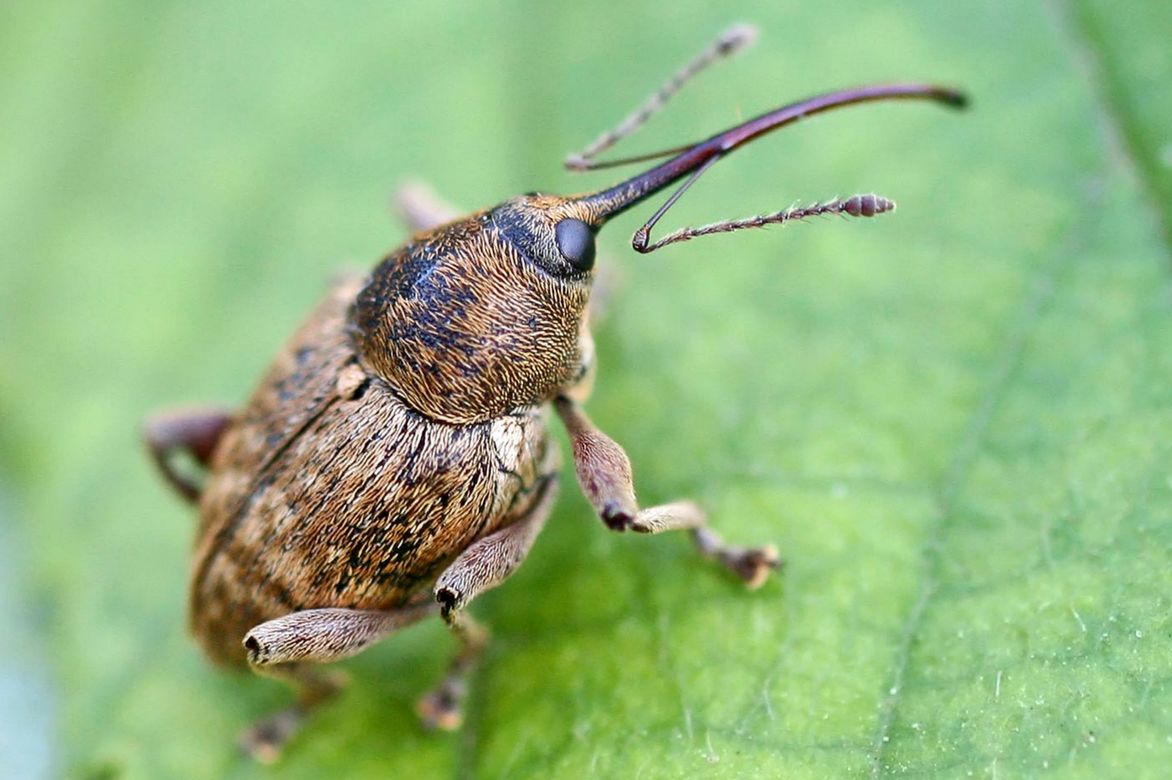 Hazel weevil or nut weevil (Wikipedia).
Hazel weevil or nut weevil (Wikipedia).
To learn more about this insect, read our dedicated advice sheet on the hazel weevil.
Some caterpillars and sawflies may attack the foliage without causing significant damage, as well as aphids.
Increased vigilance is required regarding a Japanese beetle (Popillia japonica), not yet reported in France but causing significant damage in Italy, the United States, and Canada to various fruit trees, including hazels. It turns the leaves at the top of the tree into lace when temperatures exceed 21°C. It is the size of a cockchafer with metallic green reflections on the head and thorax, and copper-coloured elytra. Any presence of jagged leaves should be reported to the Plant Protection Service. Its white grub (larva) primarily attacks grass roots.
→ Learn more about hazel diseases and pests in our advice sheet.
Multiplication
The multiplication of Corylus is often done by sowing fresh hazelnuts as the populations are quite homogeneous from selected seeds or by separating suckers.
Sowing
Sow the hazelnuts as soon as possible after the autumn harvest under a cold frame. Bury the seeds spaced 7 cm apart at a depth of 6-8 cm in well-aerated soil enriched with compost. Germination usually occurs in May. You can leave the young plants in the nursery for 2 years before any potential grafting or quickly transplant them into deep pots. In this case, you will protect them under a cold frame during the first winter before planting them out in the following spring. Rooting reaches a depth of 30 cm in the first year while the aerial shoot is half that.
Seeds that have been stored must undergo a prior soaking in hot water for 2 days, followed by 2 weeks in a warm environment before being stratified in cold conditions for 3-4 months. Germination then requires 1 to 6 months at 20°C.
Uses and associations
Thanks to their tendency to sucker, hazel trees mostly form large, thick clumps reaching 4 m in height with rapid growth. They are perfectly suited for screening views, occupying the back of the garden, creating a woodland edge, or protecting your plants from the wind. However, Corylus maxima, the Lombardy hazel, has a more arborescent structure even though it remains a small tree with a short trunk. Corylus colurna forms a pyramidal tree that hardly exceeds 10-15 m in urban planting and does not produce suckers.

An example of association in a hedge: Corylus avellana ‘Red Majestic’ (Sapho), Cornus ‘Eddie’s White Wonder’, Amelanchier lamarckii, Malus ‘Liset’.
The contorted hazel, easy to grow in ordinary soil that is not too dry, will delight lovers of unusual plants. It forms a beautiful focal point in the garden during winter, allowing one to admire its zigzagging branches and large yellow or purple aments. It is obviously magnificent when planted alone, and this is how it will be highlighted, especially in winter when its distinctive silhouette emerges against a leaden sky. One might also place it in a Japanese-style garden, in a sunny location. It is permissible to imagine a small blue-flowered clematis (Clematis alpina or integrifolia) sprawling at the base of an already mature tree while climbing its branches. Cultivating it in a large container on a terrace or balcony is also possible. Gardeners who appreciate curiosities will also adopt the curious Robinia Tortuosa in a spacious garden.
The hazel thrives in groups at the edges of the garden or within a free-standing hedge, fruiting or windbreak, alongside flowering apple trees, amelanchiers, dogwoods, rowans, Eleagnus, and many others.
→ Discover more association ideas with the hazel in our advice sheet.
Did you know?
Turkey produces 60% of the world’s cultivated hazelnuts, across all species. The origin of the production hazel trees is unclear; they likely derive from the three species present in Turkey: colurna, avellana, and maxima.
The planting of the Byzantine hazel helps combat soil erosion. It is native to south-eastern Europe and Asia Minor, ranging from the Balkans to northern Iran and the Himalayas, passing through northern Turkey. It mingles with oaks, beeches, and maples in leafy forests, as well as with firs and beeches in other woodlands. Its cultivation began in Turkey as early as the 16th century, contributing to its naturalisation as far as Lower Austria. In Russia, the population of Byzantine hazel is declining, which is not the case in the rest of its natural range.
The pollen of common hazel allows for climate tracing due to its ability to colonise environments after a glaciation period. A large quantity of pollen is also an archaeological indicator of open environments, whether due to human activity, fire, or herbivores.
To go further
- Discover our wide range of Corylus.
- Find our tips on how to harvest and store hazelnuts
- Some advice on choosing a hazel tree
- Hazelnuts: cultivation, harvest, and delicious recipes
- Discover our advice sheet: Growing shell fruits in the garden
- Subscribe!
- Contents

































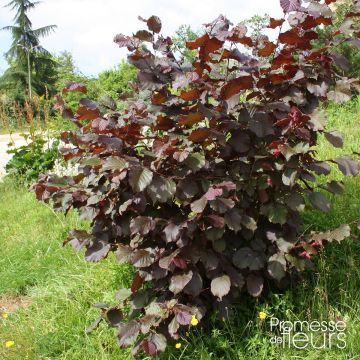
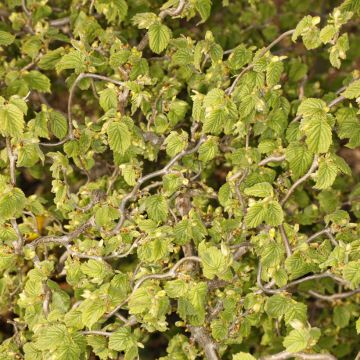
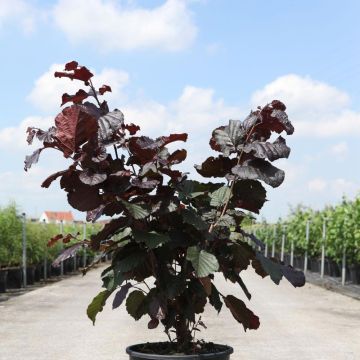
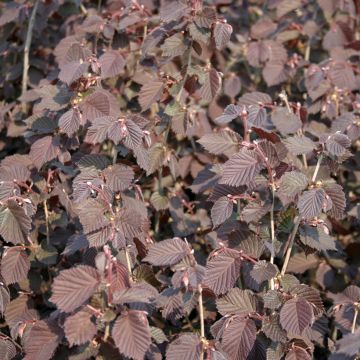

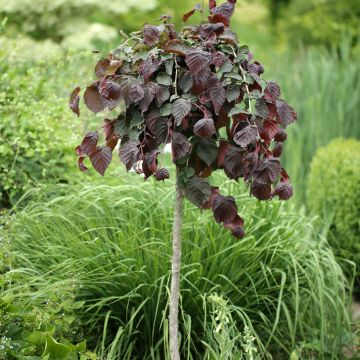

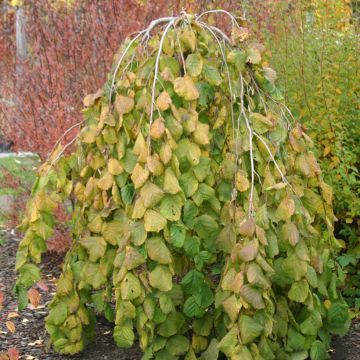
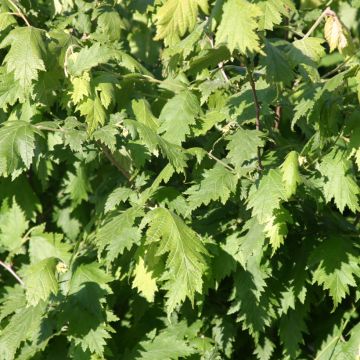
Comments